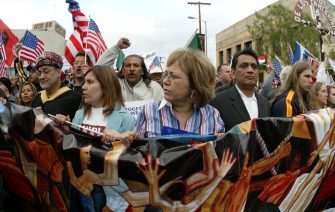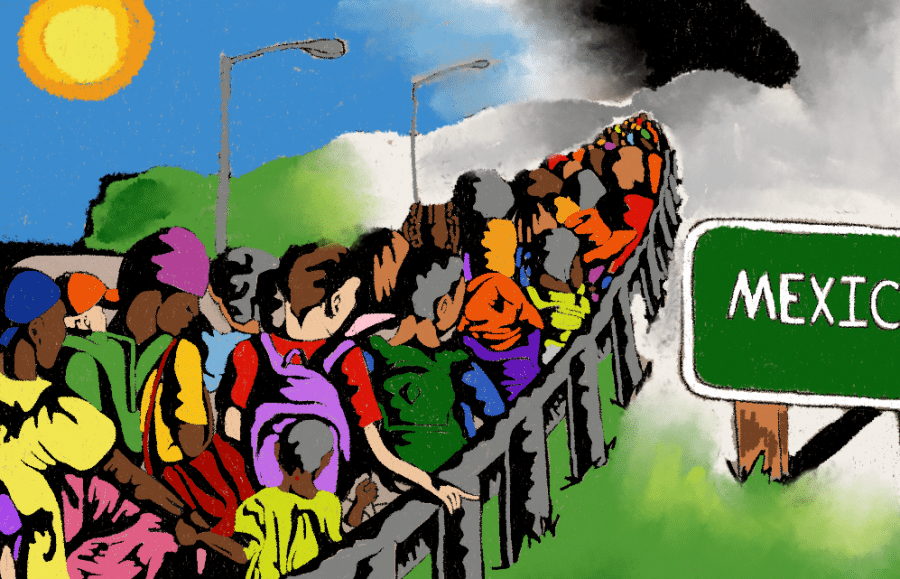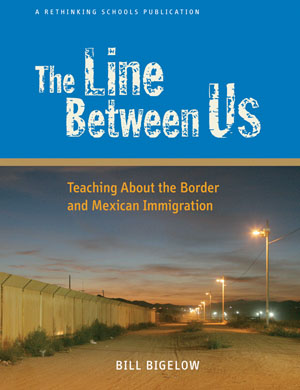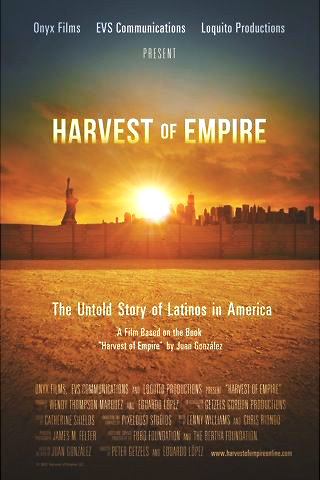In Spring 2006, hundreds of thousands of immigrants’ rights activists marched in cities across the United States to protest Congressional legislation intended to increase the criminalization and deportation of “undocumented” immigrants. The protests began in March of that year and lasted until May, and focused the mainstream media’s attention on immigrant rights.

Immigration rights demonstrators march Monday, April 10, 2006, through downtown Los Angeles. Source: ZUMA Press, Inc/Alamy
On Monday, April 10, 2006, the largest number of people gathered in over 100 cities in the United States to protest the proposed anti-immigrant legislation. Ultimately, the bill that sparked the protests that year passed in the House but failed in the Senate.
Hundreds of newspapers covered the protests. Here are excerpts from the Democracy Now! April 11, 2006 report, followed by a video of the full broadcast:
Across the United States, hundreds of thousands of undocumented workers, legal immigrants, labor unions, immigrant rights advocates and their supporters demonstrated in what was billed as the National Day of Action for Immigrant Justice.
In New York, over 100,000 demonstrators converged in lower Manhattan for a rally near City Hall. In Atlanta, as many as 80,000 people flooded the streets. In Phoenix, an estimated 100,000 rallied at the Arizona Capitol. 50,000 marched in Houston. 25,000 in Madison, Wisconsin. 10,000 in Boston. 8,000 in Omaha, Nebraska. In Fresno, California 10,000 people turned out in what a police spokesman called “by far the largest event we have ever had in the city.” Even in the tiny farming town of Garden City, Kansas, 3,000 people took to the streets–more than 10 percent of the local population.
The rallies Monday followed a day of demonstrations in San Diego, Miami, Birmingham, Alabama, Utah, Idaho and Iowa. A Sunday rally in Dallas drew half a million people, the largest protest in the city’s history.
Many are likening the extraordinary national mobilization to a second civil rights movement.
One of the largest protests on Monday took place in Washington DC. Hundreds of thousands streamed past the White House to a rally on the National Mall. The demonstration took place just yards from the Capitol, where Senators last week failed to reach agreement on wide-ranging immigration reform that would allow the 11 million undocumented immigrants living in this country a chance to work here legally and eventually become U.S. citizens. The Senate will resume the debate on the issue in two weeks” time, after the spring recess. The House passed its own bill in December that has been described as the most repressive immigration bill in 70 years. HR 4437 would, among other things, turn every undocumented immigrant into a felon and make it a crime to offer help to undocumented immigrants.
Meanwhile, in New York City over 100,000 took to the streets. Thousands converged on City Hall Park for a massive rally. Among those who addressed the crowd was Roger Toussaint, president of the Transport Workers Union:
Everyone here should think long and hard about what is happening in America today. We have a government that creates immigrants by the millions and then mistreats them. I say the U.S. creates immigrants the old-fashioned way. If you have tyranny and oppression and famine and poverty around the world, you are going to have immigrants coming to the U.S. No wall is going to stop them. No fence with barbed wire on the Mexican border or no frozen moat on the Canadian border is going to stop them. It will just make it easier to arrest and brutalize them. We don’t need a wall. We need a new foreign policy, so people can make a decent living and live in peace in their home countries.
Full broadcast below: Immigrant Rights Protests Rock the Country: Up to 2 Million Take to the Streets in the Largest Wave of Demonstrations in U.S. History | Democracy Now! | April 11, 2006
More Events
Two other significant days over the course of the Spring protests were March 25 and May 1. On March 25, the largest single-city protest occurred in Los Angeles with estimated 500,000-1.5 million people. May 1 was the “Day Without Immigrants” or the “Great American Boycott.” On that day in May, pro-immigrant activist groups organized people to skip school, work, and not purchase goods from American companies in order to show non-immigrants the presence and power of immigrants living in the United States.
Find lessons and other resources below to teach outside the textbook about immigration.











Twitter
Google plus
LinkedIn